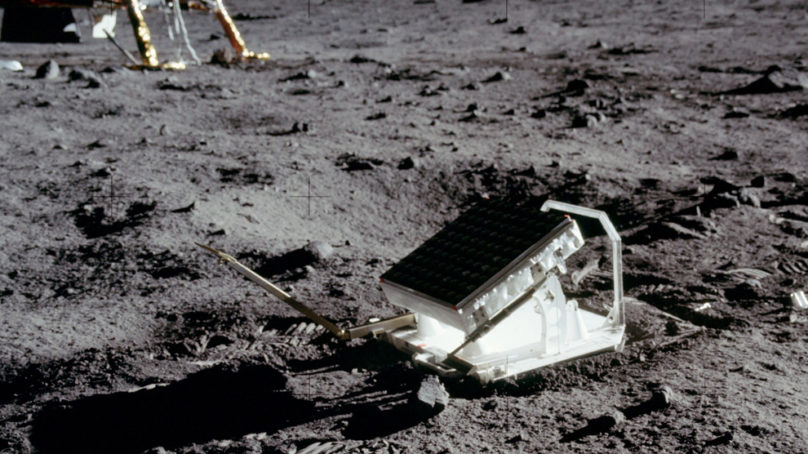
The Speed of Light is a key to our understanding. Our electronics, the computer you are using, and even the human brain operate at the speed of this “universal constant.” Through light our eyes and telescopes perceive much of the universe. Our sciences of astronomy, Relativity, and quantum mechanics depend on light—and its speed limit of 186,282 miles per second. While nothing can exceed this upper bound, as I write, a simple equation predicts that the speed of light is slowing. And to this end, the most accurate clocks ever built, placed aboard space stations, will soon be in a race to measure light’s actual—if not changing—speed.
400 years ago, when Galileo’s telescope saw First Light, there was some controversy as to whether light had any speed at all. Many learned minds, Johannes Kepler for example, thought that light simply travelled instantaneously. Galileo, himself, suggested timing light’s passage with lanterns on hilltops, but lacked a distant-enough hill or an accurate clock to carry out the experiment. A careful experimenter, Galileo could only conclude that if light did have a speed, it was too fast to measure.
Ole Romer in the City of Light
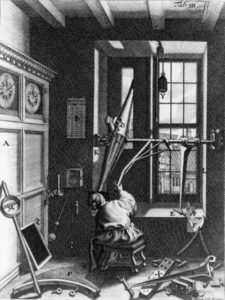
Ole Rømer observes through his kitchen in Kannikestræde with the passage instrument.
The Speed of Light was discovered in the City of Light. The first indication came from one of Galileo’s discoveries, the moons of Jupiter. In the 1670s astronomers at the Paris Observatory had found an anomaly in observations of the innermost moon, Io. At times the moon would appear from behind Jupiter later than predicted. Ole Rømer, a Danish astronomer working at Le Observatoire, realized that the delay was due to the speed of Io’s moonlight reaching Earth.
Romer was able to predict that on a certain day in 1676 Io would appear from behind Jupiter ten minutes late. Though the moon appeared at exactly the time that Romer had predicted, few believed him. The Observatory’s director, Domenico Cassini, refused to believe that there was anything to the notion of the speed of light. Fifty years would pass before experiments on Earth verified that Romer was right.
Today the Speed of Light is part of our science. The equations of James Clerk Maxwell showed that light is a form of electromagnetic radiation propagating at speed c. The Speed of Light is also a key component of Einstein’s Relativity. Though c has been measured at 299,782 kilometers per second, why it has precisely that speed has been a mystery. Perhaps equally intriguing is why it might be slowing down.
Before graduating from university, I came up with mathematics predicting an evolving universe. This can be summarized in a simple form, the only equation in the book:
GM=tc3
where G is Newton’s gravitational constant, M and t are mass and age of the universe.
When t was tiny, c was enormous and the universe expanded in a Big Bang. As time t increased, c slowed due to gravity, and it continues to slow today at a tiny rate. In one year the speed is predicted to slow by only 0.72 centimeters per second. This small change has been difficult to detect. Notwithstanding, we are still told in school that c is fixed for all time.
I’ve had the privilege of studying the moon as a scientist at NASA Johnson Space Center in Houston. In my day job, I performed experiments with priceless Apollo lunar samples. With my background in physics and astronomy, I wondered whether Apollo 11’s Lunar Laser Ranging Experiment (LLRE) could tell if light has, in fact, been slowing. Recall that Galileo lacked a distant-enough hill by which he might measure the speed of light. Well, we have had footprints on a distant hilltop since July 20, 1969—on the moon.
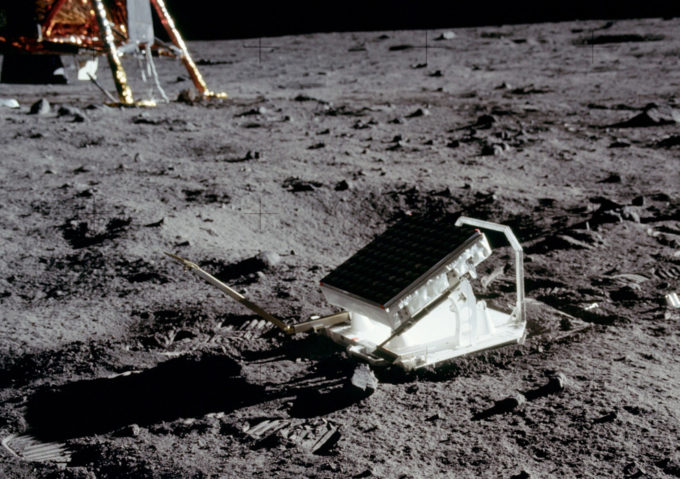
Lunar Laser Ranging Experiment, July 20, 1969.
The first LLRE was left behind by Armstrong and Aldrin at Tranquility Base. It is composed of quartz corner reflectors—similar to bicycle reflectors—that send laser pulses back in the direction from which they originate. This allows lasers on Earth to measure the moon’s distance with centimeter accuracy. Nearly all things change with time, and the moon’s distance has been slowly increasing due to tidal interaction, causing Earth’s length of day to increase proportionally.
LLRE has reported the increase at 3.82 +/-.07 centimeters per year, but that is too fast. If the moon were today gaining momentum at this rate, a simple calculation shows that it would have coincided with Earth 1.5 billion years ago. Studies of lunar samples, with which I have participated, show conclusively that the moon has existed separate from Earth for over 4.5 billion years. Other ways to measure the moon’s orbital evolution also disagree.
One method uses fossilized sediments called tidal rhythmites. These are formed when ancient tides leave layers of sediment on a daily and bimonthly cycle. This allows geologists to determine the length of a month and distance to the moon many millions of years ago. The Mansfield Sediment of Indiana, the most recent to be studied, indicates that 310 million years ago the moon’s distance was 375,300 +/- 1900 kilometers. Subtracting from the current distance of 384,402 km and dividing by 310 million years, I calculated the moon’s average recession of 2.9 +/- 0.6 centimeters per year. LLRE’s measure is 1/3 greater.
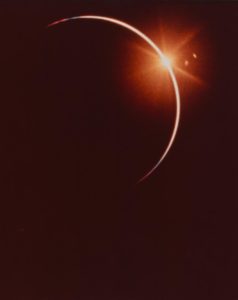
During the return to Earth the Apollo 12 command module went behind the Earth relative to the Sun, causing the eclipse seen in this photograph. The image was taken shortly before reentry on 24 November 1969.
In March 2016 I witnessed a total eclipse from a ship in the Pacific. Astronomers have been reporting eclipses for over 2,700 years. The path of totality is narrow: if an astronomer in Babylon reported a total eclipse on a certain day in 136 B.C., it provides a precise measure of how much momentum has been transferred from Earth to the Moon, with accuracy rivaling that of LLRE.
If the moon were receding at 3.82 centimeters per year, Earth’s length of day would increase by 2.3 milliseconds each century. A study of 2,700 years of eclipses, compiled by Richard Stephenson and Leslie Morrison in the United Kingdom, shows Earth’s day increasing by only 1.78 +/- .03 milliseconds per century. Their most recent data was published in December 2016. From this I calculated the lunar distance increasing 2.96 +/- .05 centimeters per year, agreeing with sedimentary data. LLRE differs by over 12 standard deviations.
A third dataset comes from numerical simulation. Tidal action is subject to the depth of Earth’s ocean basins, location of the oceans, and how the continents have moved over time. These factors can be easily modeled in computers, and even used to predict today’s tides. Numerical simulation by Eugene Poliakow in Russia calculated that the moon is receding at 2.91 centimeters per year, matching sedimentary and eclipse data.
Small deviations in planetary orbits can have great significance for cosmology. The delay in appearances of Jupiter’s moon was found by Ole Rømer to be due to the speed of light. Mercury’s orbital ellipse precesses by 5,600 arc seconds per century, but a discrepancy of 43 arc seconds per century was a proof of General Relativity. Physicists seek 2-3 standard deviations, called Sigma, as proof. If LLRE reports the Moon receding 1/3 faster than three independent experiments—more than 12 Sigma—it is a huge anomaly.
If its speed were slowing, the time for light to return would increase each year, making the moon appear to be receding faster, according to LLRE. Using an estimated age of the universe of 13.82 billion years, GM=tc3 predicts .927 centimeters per year. This matches the 12-sigma anomaly within a fraction of a standard deviation, making it one of the most accurate scientific predictions of all time. This finding was published in the Planetary Science journal in 2012. You can read more about this in my popular science book, The Speed of Light.
Applications: The Cosmic Microwave Background
A changing Speed of Light would solve many mysteries. It would tell us how the Big Bang started, explaining features of the Cosmic Microwave Background more precisely than older ideas. For 35 years physicists believed that c was fixed, but the early universe expanded at warp speed, many times faster than light. Such cosmic “inflation” posed many problems, since no possible experiment could ever test it. It would require imaginary repulsive energies with finely-tuned parameters to achieve the universe we observe today.
The Microwave Background was briefly front-page news in March 2014. An experiment called BICEP2 at the South Pole claimed to have found waves from the beginning of time—“smoking gun” proof of inflation. When the data was re-examined, the collaborators were found to have seen dust. Though gravitational waves from other sources have since been found, there has been no breath of “inflation.” If light were faster in the early universe, it would explain today’s observations without repulsive energies.
Applications: Earth Climate
A changing c also would explain the “Faint Young Sun” paradox of Earth’s climate. According to theories of astrophysics, life should not have evolved on Earth at all, because 3.5 billion years ago the sun was only 75% as luminous as it is today. Earth would have been frozen solid, its icy surface reflecting sunlight back into space. We are also taught that, regardless of human activity, the sun will continue to grow hotter until Earth’s oceans boil.
Paleontologists have found evidence of liquid water and life on Earth 3.5 billion years ago. In 1996 the scientists I worked with at Johnson Space Center found signs of fossilized life in a Martian meteorite 3.5 billion years old. During the past 20 years spacecraft in orbit and on the surface of Mars have found that early Mars once contained liquid water, and even an ocean. Something has kept both Earth and Mars warm enough for life.
The sun turns its fuel to energy according to E=mc2. If c billions of years ago were higher, as GM=tc3 predicts, the sun would have been almost exactly as luminous as today. The “solar constant,” the amount of sunlight reaching Earth, may be nearly constant. If the Speed of Light had not changed in the amounts predicted, we would not be alive to observe it.
Quantum Values and Thermodynamics
Some measurements of distant quasars appear to indicate that the fine-structure value, which is dependent on Planck’s value h multiplied by c, may have changed. If the product hc is fixed, it would mean that h grows over time and quantum mechanics is linked with Relativity. Planck’s value explains the thermodynamic “arrow of time,” which is why entropy increases.
Supernovae
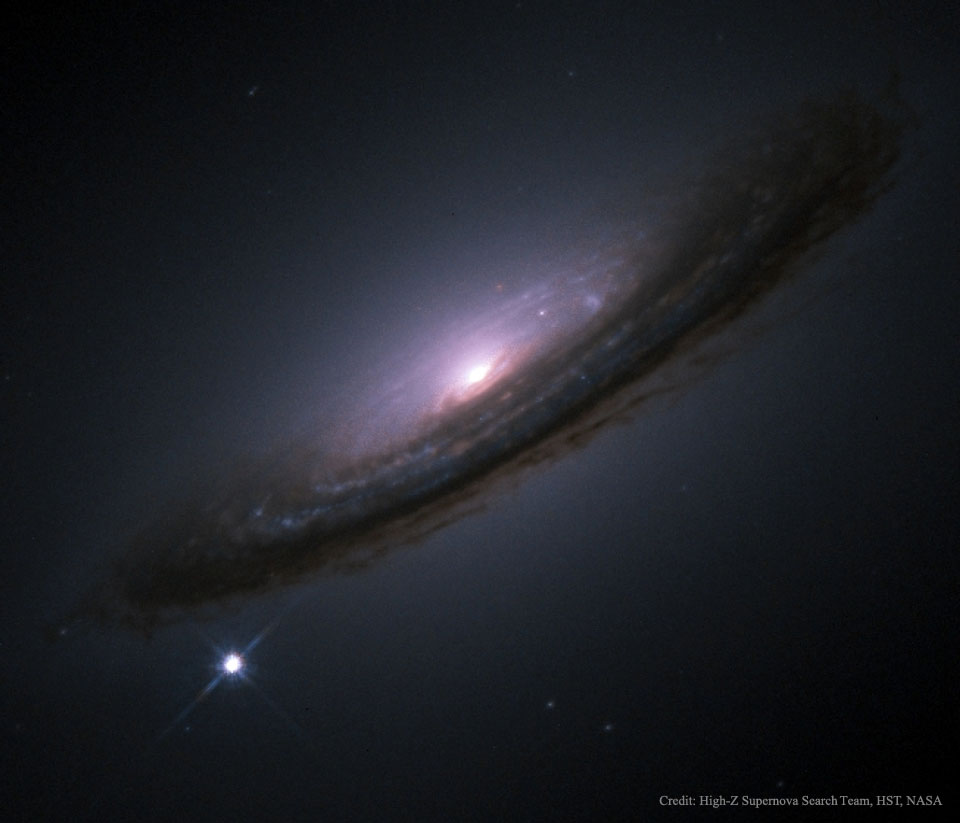
Supernova 1994D. Image courtesy of High-Z Supernova Search Team, HST, NASA
We may finally shed light on one of the biggest mysteries in physics: the redshifts of distant exploding stars. We have known since the time of Edwin Hubble that the universe expands, because the greater an object’s distance, the more its light is shifted into the red. When physicists looked at distant Type Ia supernovae, they found the redshifts increasing non-linearly, as if expansion were accelerating. This discovery was awarded the 2011 Nobel Prize in physics. Cosmic acceleration would violate many laws of nature, starting with Conservation of Energy. To explain the accelerating data, physicists had to conjure a repulsive “dark” energy filling all of space. Nothing like “dark” energy has ever been observed in nature.
Redshifts are related to v/c, velocity divided by the Speed of Light. If c were changing according to GM=tc3, it would explain supernova data more precisely than any dark thoughts. With thanks to NASA’s Beyond Einstein program, I published this data fit in 2004.
Atomic Clocks in Space
The other way to complete Galileo’s experiment is with a better clock. Mechanics and electronics enthusiasts have always been interested in a more accurate timepiece. In 2017 the Atomic Clock Ensemble in Space is scheduled to be launched aboard ISS. In space an atomic clock is more accurate than any clock on Earth because Earth’s gravity does not interfere with vibrating atoms. One of ACES’ principal science goals is to search for anisotropies, or changes in the Speed of Light. A European Space Agency project, ACES has been built and is scheduled to join ISS aboard Cargo Resupply Sortie 13 (CRS-13) in August 2017. It will be placed by the station’s robotic arm outside the Columbus laboratory module.
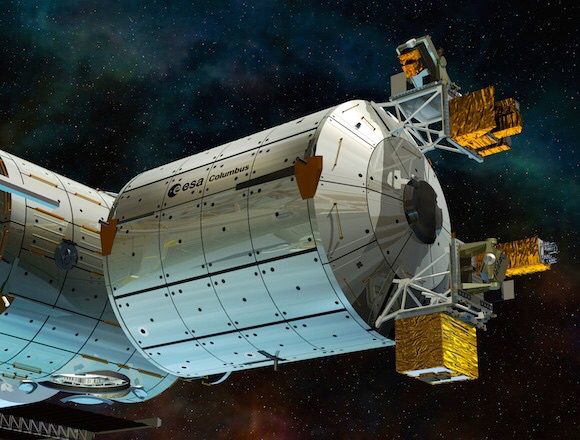
Atomic Clock Ensemble (lower right) attached to the Space Station.
Though a changing c is not common knowledge, Earth’s most populous nation is interested. On September 15, 2016 China launched the Tiangong-2 space station module. On the same day China’s space agency announced that the module carries an atomic clock, which they claim is the most accurate ever built. The Chinese atomic clock will be used to test “fundamental measurements,” meaning the Speed of Light. With two competing atomic clocks spinning aboard two space stations, researchers will be motivated to announce discoveries even before they are made. Will atomic clocks verify a discovery about c? Time will tell!

Cold-atom clock currently orbiting in the Tiangong-2 module.
A Sputnik Moment?
60 years ago, 1957 America was caught completely by surprise when a rival nation made a huge scientific advance: the first artificial satellite. The signal from Sputnik, spreading at the Speed of Light, changed the world below and heralded the advent of the Space Age. Within a few months there may be another “Sputnik Moment” as China or the European Space Agency verifies a changing c.
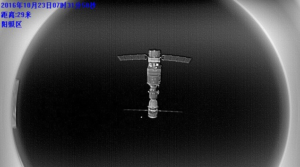
The Tiangong-2 module in orbit.
The night sky may seem dark, but we live in a universe of light. It began in a burst of electromagnetic energy expanding with the Speed of Light. Light fills space from the microwave background to the radiation from our sun. It has been tempting to claim that the universe is filled with invisible “dark” energies, but all things change with time. We may soon witness a “c change” in science.
For Further Reading
Riofrio, L., “Calculation of Lunar Orbit Anomaly,” Planetary Science, 2012 (https://planetary-science.springeropen.com/articles/10.1186/2191-2521-1-1)
Riofrio, L., “GM=tc3 Space/Time Solution of Supernova Data,” Beyond Einstein, 2004 (http://www-conf.slac.stanford.edu/einstein/talks/aspauthor2004_3.pdf)
Stephenson, F.R., Morrison, LV., Hohenkerk, C.Y., “Measurement of the Earth’s rotation: 720 BC to AD 2015, ” Proceedings of the Royal Society A, V. 472, No. 2196 (2016)
Bills, B.G., Ray, R.D., “Lunar Orbital Evolution: A Synthesis of Recent Results,” Geophysical Research Letters, V. 26, No. 19 (1999)
Fact sheet on ACES: http://wsn.spaceflight.esa.int/docs/Factsheets/20%20ACES%20LR.pdf
China’s atomic clock in space: http://www.chinadailyasia.com/chinafocus/2016-11/07/content_15522116.html
About the Author
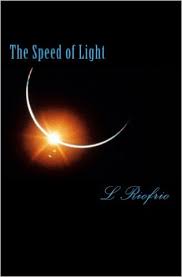 Louise Riofrio became fascinated by science while watching space flights on television. At age 16 Riofrio was studying physics at a top university. While studying the moon as a scientist at NASA Johnson Space Center in Houston, Riofrio found evidence that the speed of light was slowing down. She also performed experiments with priceless Apollo lunar samples. She is known worldwide for her theories about light, and has lectured before scientific conferences across the globe. Riofrio is the author of the popular book, The Speed of Light.
Louise Riofrio became fascinated by science while watching space flights on television. At age 16 Riofrio was studying physics at a top university. While studying the moon as a scientist at NASA Johnson Space Center in Houston, Riofrio found evidence that the speed of light was slowing down. She also performed experiments with priceless Apollo lunar samples. She is known worldwide for her theories about light, and has lectured before scientific conferences across the globe. Riofrio is the author of the popular book, The Speed of Light.


